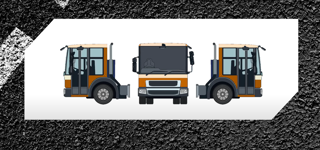Phil Lloyd, head of engineering and vehicle standards at the Freight Transport Association (FTA)
The Covid-19 outbreak has forced many companies to leave their vehicles idle, but with government scientists starting to see the levels of infections plateauing, and other European countries gradually lifting their lockdown restrictions, now is the time to start preparing fleets for the possible return to business.
In addition to meeting legal requirements, well maintained vehicles improve reliability and safety, while reducing emissions and the likelihood of accidents; this is the perfect time to reinforce strong vehicle safety standards among drivers and managers.
Driver responsibility
Daily vehicle checks supplement regular servicing and safety inspections by identifying defects that may occur during daily use. As drivers are not expected to have in-depth mechanical knowledge, these checks – to be conducted by the driver before using the vehicle – should be focused primarily on what is reasonable to be seen and assessed.
In the cab this would include checking the windscreen for cracks or scratches; that mirrors are in the place, secure and not damaged; that dashboard warning lights and gauges are working correctly; and that there are no objects obstructing the vehicle’s front view.
Outside of the vehicle, in addition to checking tyres, lights, etc. drivers should check that the fuel filler cap is fitted correctly and there are no fuel or oil leaks; the battery is secure and the exhaust is not emitting an excessive amount of smoke.
These are just a few examples; there are several accessible guides and videos drivers can refer to for a full list of items to check, such as the Government’s Guide to Maintaining Roadworthiness, which uses pictograms for illustration.
If a driver identifies a defect, it must be recorded and reported. There are a variety of ways to do this, from using printed daily walkaround sheets to apps installed on their phones; it is up to companies to decide the best option for their needs.
In the UK, bridge strikes are becoming more of an issue, so drivers must ensure that they are aware of the height of their vehicle and/or load before departing on a journey and to ensure they can negotiate safely under any bridge along their route. As the Direct Vision Standard (DVS) is due to be introduced in London in 2021, drivers will need to ensure that any cameras, warning signs, etc. are visible and working before entering the capital once the scheme is in force.
Remember, once a driver takes their vehicle onto the road, they are responsible for its condition – and can be held accountable.
Operator responsibility
Operators are responsible for two key maintenance areas: servicing and vehicle inspections. Dependent upon the use of a vehicle, services should be undertaken at the periods recommended by their manufacturers; the aim being to keep the vehicle working both efficiently and safely.
Safety inspections are periodic inspections aimed at identifying the vehicles roadworthiness condition and levels of wear or deterioration, and to replace or fix any defects. Dependent upon use, these inspections may be undertaken every four, six, eight or 12 weeks.
FTA’s Vehicle Inspection Service (VIS) is remaining operational throughout the crisis. We have made alterations to our inspection processes to ensure that we are still able to deliver our services to keep your operation legal, compliant and safe while minimising the risk of infection for our engineers and our clients.
For more information please visit fta.co.uk/vehicle-inspection-service



















Login to comment
Comments
No comments have been made yet.